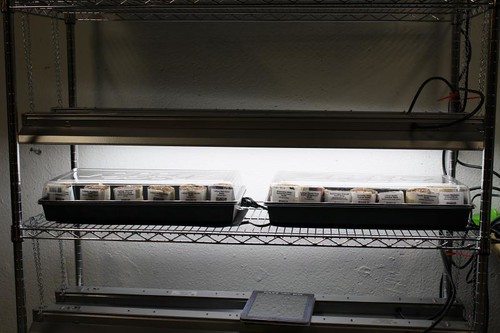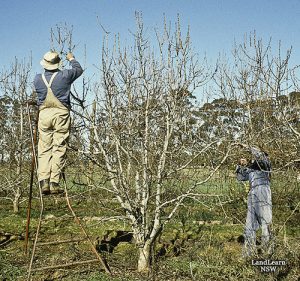February is still winter but days are getting longer and temperatures are inching their way up from the January lows. Edible gardeners want to get moving to acquire seeds, start seeds indoors for mid-to-late March transplanting of cool weather crops, and to make sure tools and equipment are ready to go. It is also a good time for fruit growers to plan new plantings and prune existing trees and bushes.
Planning
As we’ve discussed in recent issues, maintaining a garden journal can really contribute to gardening success. If you haven’t done it yet, now is the time to:
- Make a reproducible sketch of your garden area. Organize where you will plant different vegetables, herbs, and flowers, making sure that tall plants don’t shade short ones, that plants are rotated through the garden on a 3-year cycle to minimize disease prevalence, and utilize intensive gardening techniques to get the most out of your space while helping reduce weeds and insect issues.
- Review hardiness and time-to-harvest information from seed packets to plan when to make initial and follow-up plantings to maintain a steady harvest and progress from spring to summer to fall crop plantings.
- Review seed catalogs to choose what to purchase this year. Check the new All America Selection Winners 2021 to see what’s new and interesting.
- Clean, sharpen and lubricate your hand and power tools, and clean and disinfect pots and containers with a 10% bleach solution.
- Check your seed inventory so you don’t waste time trying to germinate non-functional seeds. Find guidance for germination testing in the January 2019 Garden Shed article “Good Seeds, Bad Seeds”
Seed Starting

“seeds started” by anneheathen is licensed under CC BY 2.0
Starting plants from seeds is less expensive and allows gardeners a broader variety of selection than buying transplants from local garden centers. Here are some guidelines for successful seed starting:
- Planting is typically best done about 6-8 weeks before transplanting. Starting too soon yields leggy, spindly plants that don’t do well outside.
- Light is important. It can come from a south facing window or a fluorescent fixture equipped with one warm and one cool fluorescent bulb. Commercial grow lights also work well. Keep the light about 6 inches above the the tops of plants, and keep it on for about 16 hours per day.
- A sterile potting mix that is fine, uniform, loose, and aerated is best. Common commercial mixes are a combination of peat and perlite or vermiculite. In any case, start with something that is insect, disease, and weed seed free.
- Most plants prefer a temperature of 65-75°F. If the growing area is cooler than this, a heating mat is a good idea for both germination and seedling growth.
- Containers can be anything from purchased or home-made flats to vegetable cans to yogurt containers. It is essential that they have drainage holes. Space seeds in flats according to the package directions, and thin overly dense seedlings soon after germination.
- Plant seeds at a depth of 2-3 times their diameter (not length). Moisten thoroughly after planting. Keep moist, not soaked. If it dries out, the seed won’t germinate. Too wet invites fungus and damping off.
- To help maintain soil moisture while waiting for germination, cover pots or flats with clear plastic wrap or other clear cover. Keep soil below the top of the flat or container so that any cover is an inch above the soil. Remove cover immediately after germination.
- Transplanting should take place after one or two sets of true leaves appear.
- More on transplanting next month.
For another, more detailed look at indoor seed starting, see this month’s article, How to Start your Garden Seeds. The VA Cooperative Extension offers good advice for seed-based gardening in Plant Propagation from Seed and Seed for the Garden.
VCE publication Virginia’s Home Garden Vegetable Planting Guide offers guidance for both planting times and which vegetables are best transplanted vs direct seeded outside. In hardiness zone 7a, March is the time to transplant broccoli, cabbage, cauliflower, and head lettuce. So get those seeds started now to be ready to transplant next month.
Organic Weed Management
If you dislike weeding during the summer, you might like to try occultation as a technique for weed control. Its use is increasing in the organic market-farming community. The first step is to cut your cover crop or trim all growing vegetation in the garden beds as close to the ground as possible. Then cover beds with black plastic sheeting or tarps, well secured around the edges. Keep light out and let the sun’s heat penetrate the soil for 6 weeks or more. Then remove the plastic, rake off dead vegetation and rake the surface smooth to be ready to plant.
Reports in organic gardening literature claim significant reduction in weed infestation and weeding labor when following this technique. I’m trying it for the first time this year and will report results in a couple of months.
Fruit Grower Tasks

The best time to prune fruit trees is while they are dormant, just prior to active growth. Pruning helps manage tree size and shape. Most importantly, it can help trees support heavy crops without damage while allowing abundant air and sunlight penetration. At a minimum, remove dead and damaged wood. Remember to disinfect cutting tools before and after. Detailed guidance for fruit tree management is provided in the VCE publication Tree Fruit in the Home Garden.
A broader-based article on good pruning practice for a variety of trees and shrubs is available in the article A Pruning Primer: Tools, Techniques and Timing from the February 2020 Garden Shed.
For guidance on growing small fruits, Small Fruit in the Home Garden is a helpful resource. It covers location, soil management, variety selection, planting, and pruning techniques for strawberries, blueberries, raspberries, blackberries and grapes. Because best practices and requirements vary significantly by type of fruit and even within varieties, it is a worthwhile read before purchasing and certainly while caring for any of these crops.
I hope you are as excited as I am to get this gardening season moving and look forward to visiting again next month.
Sources:
Seed for the Garden: https://www.pubs.ext.vt.edu/content/dam/pubs_ext_vt_edu/426/426-316/426-316_pdf.pdf
Plant Propogation From Seed: https://www.pubs.ext.vt.edu/content/dam/pubs_ext_vt_edu/426/426-001/426-001.pdf
Know Your Seeds: https://hampton.ext.vt.edu/content/dam/hampton_ext_vt_edu/mg-class-pres-21.pdf
Seed Starting: https://lee.ces.ncsu.edu/2019/05/seed-starting/
Tree Fruit in the Home Garden: https://www.pubs.ext.vt.edu/content/dam/pubs_ext_vt_edu/426/426-841/SPES-259.pdf
Small Fruit in the Home Garden: https://www.pubs.ext.vt.edu/content/dam/pubs_ext_vt_edu/426/426-840/426-840_pdf.pdf